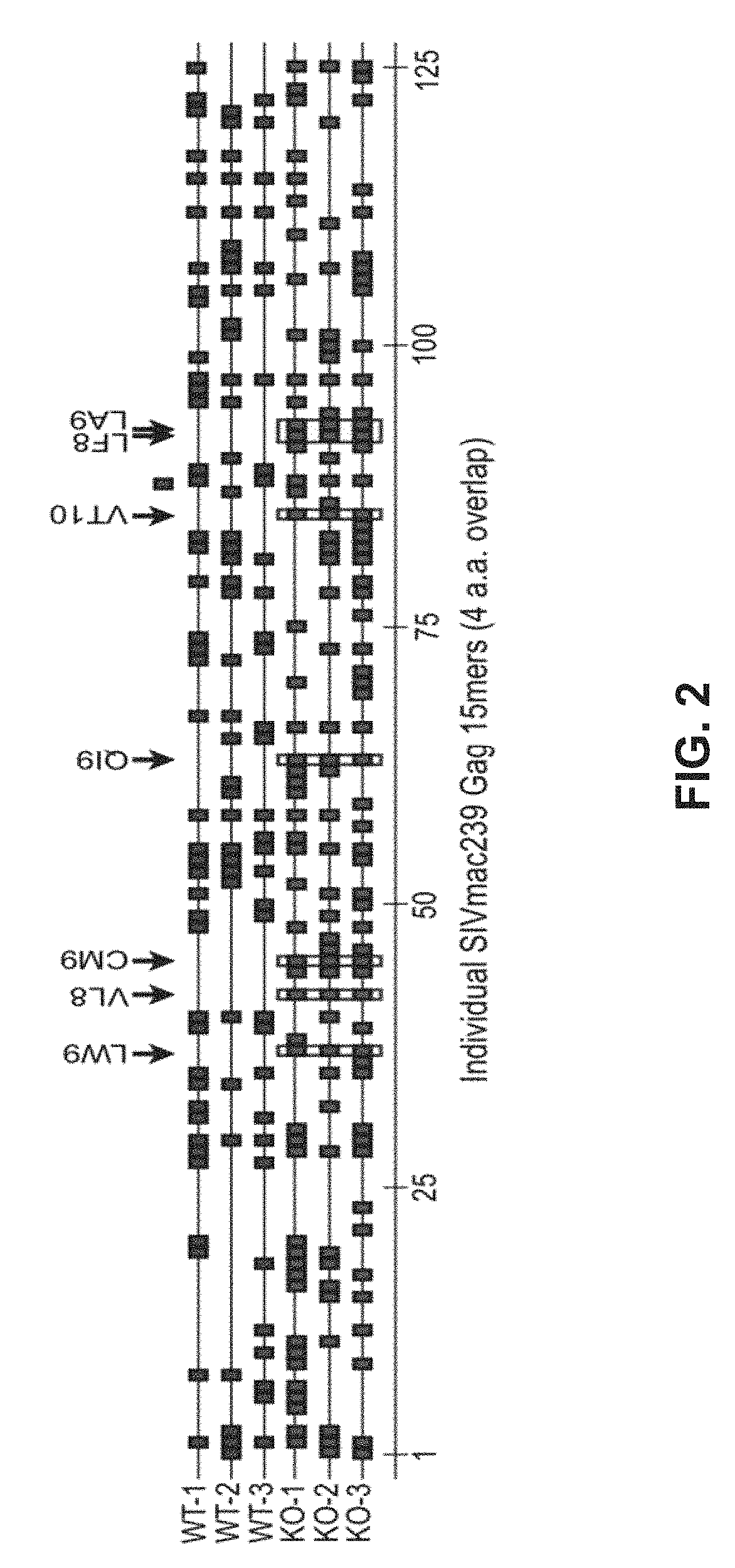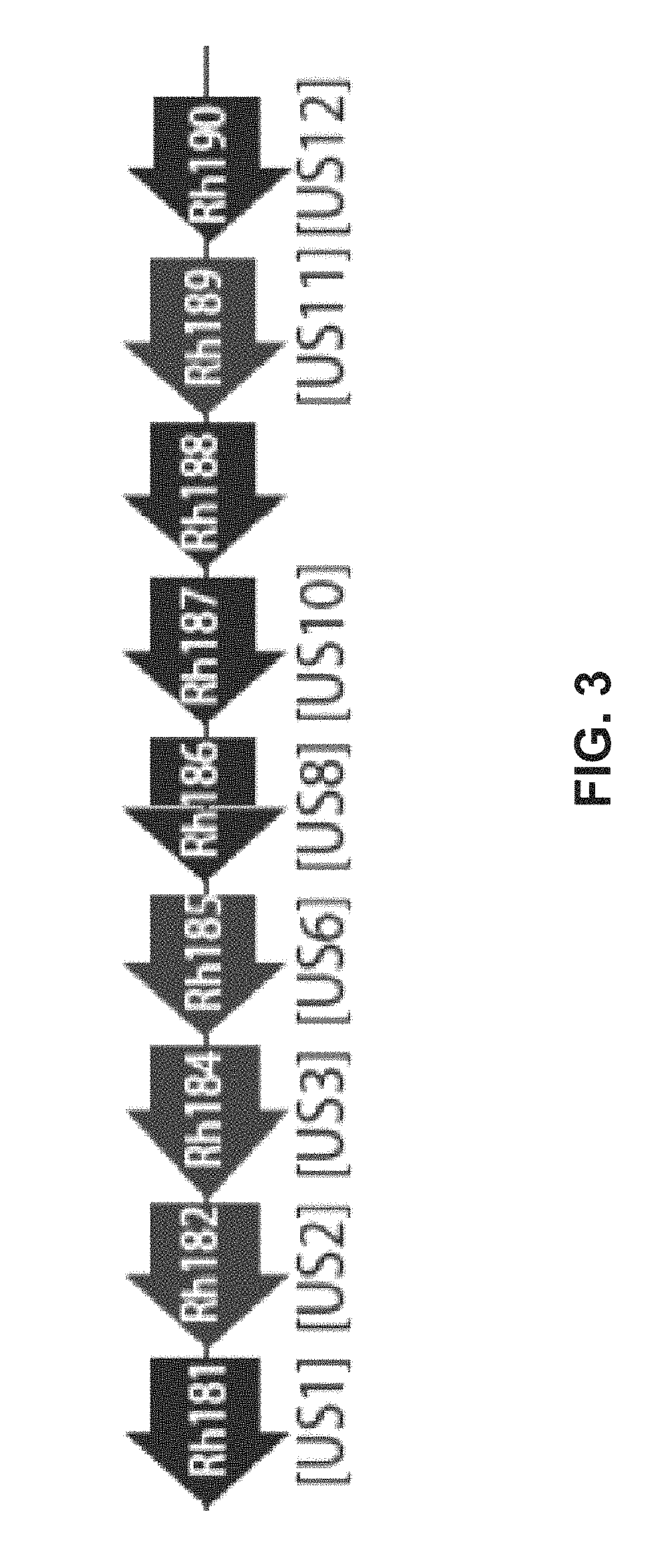CMV glycoproteins and recombinant vectors
a cytomegalovirus and glycoprotein technology, applied in the field of recombinant cytomegalovirus vectors, can solve the problems of limiting the efficacy of the t cells raised by a cmv-based vaccine, unable to eradicate the virus from healthy infected individuals, and unable to confer protection against re-infection,
- Summary
- Abstract
- Description
- Claims
- Application Information
AI Technical Summary
Benefits of technology
Problems solved by technology
Method used
Image
Examples
example 1
nt Cytomegalovirus Vectors with Improved Immunogenicity
[0188]During the course of evaluation of Rhesus macaque (Rh) CMV / SIV vector immunogenicity, SIV epitopes that had been previously shown to represent dominant targets of CD8+ T cells in SIV-infected or DNA / Adenovirus / pox vector-vaccinated Rhesus macaques were not targeted at all by RhCMV / SIV vector-elicited CD8+ T cell responses (by ICS or tetramer staining) These included 9 Mamu A*01-restricted epitopes in 12 animals; 3 Mamu A*02 epitopes in 4 animals, 1 B*08-epitope in 1 animal, and 3 Mamu B*17-epitopes in 7 animals (FIG. 1; left). HCMV and RhCMV express 4 related glycoproteins—US2 / Rh182, US3 / Rh184, US6 / Rh185 and US11 / Rh189—that act together with very high efficiency to inhibit presentation of MHC class I-restricted epitopes by infected cells Powers C et al., Curr Top Microbiol Immunol 325, 333-359 (2008); Liu Z et al., Int J Biochem Cell Biol 41, 503-506 (2009); van der Wal, F J et al., Curr Top Microbiol Immunol 269, 37-55 (2...
example 2
ion and Characterization of RhCMVΔUS2-6 and RhCMVΔUS8-11
[0190]The vectors Rh186-189 (ΔUS8-11), and Rh182-185 (ΔUS2-6) were generated through BAC recombineering. BAC recombineering begins with recombination in E. coli between the RhCMV strain 68-1 BAC and a PCR product containing the SIV gag or SIVrtn marker and a kanamycin resistant (KanR) cassette. The KanR cassette is flanked by FRT sites, and the ends of the PCR product include between 40-60 base pairs of homology to the ORF to be deleted. Recombinants are selected with kanamycin, and are then subjected to arabinose-induced recombination of the FRT sites to delete the KanR cassette. Therefore, only a gag / rtn marker and a single FRT scar remain in place of the deleted ORF. This final BAC product is electroporated into rhesus fibroblasts, from which the recombinant virus is harvested. The viruses produced by this method and included in this study are diagrammed in FIGS. 4A and 4B.
[0191]All viruses were thoroughly characterized in v...
example 3
rs Lacking US8-11 are Able to Super-Infect CMV-Positive Rhesus Macaques (RM) and CMV / SIV Vectors Lacking US8-11 Induce a Long-Term CD8+ T Cell Response to Typical Immune-Dominant SIV Epitopes
[0193]Four CMV-positive RM were inoculated subcutaneously with 107 plaque-forming units (PFU) of recombinant ΔUS8-11RhCMV / rtn and ΔUS8-11RhCMV / gag vector. Blood or BAL was collected at the indicated days and T cell responses were analyzed on the same day. In FIG. 7A, CD8+ T cell responses frequencies to the SIV antigens SIVgag and SIVrtn (fusion of rev-tat-nef) determined by flow cytometric analysis of intracellular cytokine staining for CD8+ T cells and the activation markers CD69, TNF-α and IFN-γ after stimulation of PBMC with overlapping peptides covering the SIV antigens. The percentage of the responding, SIVrtn or SIVgag-specific T cells within the overall memory subset in both the blood (left) and BAL (right) fractions are shown for each time point as the mean for all four RM (+ / −SEM). The...
PUM
| Property | Measurement | Unit |
|---|---|---|
| diameters | aaaaa | aaaaa |
| diameter | aaaaa | aaaaa |
| inhibitory concentration | aaaaa | aaaaa |
Abstract
Description
Claims
Application Information
 Login to View More
Login to View More - R&D
- Intellectual Property
- Life Sciences
- Materials
- Tech Scout
- Unparalleled Data Quality
- Higher Quality Content
- 60% Fewer Hallucinations
Browse by: Latest US Patents, China's latest patents, Technical Efficacy Thesaurus, Application Domain, Technology Topic, Popular Technical Reports.
© 2025 PatSnap. All rights reserved.Legal|Privacy policy|Modern Slavery Act Transparency Statement|Sitemap|About US| Contact US: help@patsnap.com



